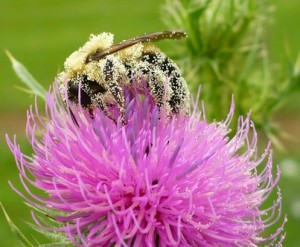Pollinators and Pennsylvania Vineyards
By: Lee Stivers
Penn State Extension, Washington County
Bees and other pollinators are big news these days. It seems that nearly every day, I run across a news article, radio broadcast, TV news clip, and several social media posts about the current plight of bees. Viruses, parasites, pesticides, habitat loss, weather; they all seem to be conspiring against the lowly bee. Conservation groups, consumer organizations, bee keepers, pesticide manufacturers, research scientists, producers, food industry officials, and policy makers are all weighing in on this growing issue, as we try to understand and respond appropriately.
Grapes aren’t pollinated by bees, so do grape growers even need to be concerned about this? Absolutely. I recently attended a conference of Penn State Extension educators, specialists and faculty that focused on the latest research findings on the status of pollinators. I learned some very interesting things worth sharing with everyone involved in the Pennsylvania wine grape industry.
Anyone who enjoys eating should be concerned about bees and other pollinators. An estimated 70% of our agricultural crops rely on pollinators, especially fruits, vegetables and nuts. Some estimates say that one out of every three bites of food we eat relies on honey bees and other pollinators. Commercial honeybee operations are reporting an average loss of 30% of their hives annually.
It’s not just honeybees; native pollinators are important too. We tend to think of bees mostly in terms of managed honeybees, Apis mellifera. But there are hundreds of species of native bees that provide significant pollination services in our crops and landscapes. These native pollinators include sweat bees, squash bees, mining bees, leafcutter bees, mason bees, and bumble bees. Early research indicates that populations of some native pollinators may also be in decline.
Why are pollinators declining? Despite what you might read in the news media, there is no simple answer to the question of why bees and other pollinators are declining in numbers. Experts on bee biology, environmental toxicology, and insect ecology generally agree that a number of factors are converging to make this a complex situation. Diseases, parasites, declining nutritional quantity and quality of food resources, and pesticide exposure are operating together, sometimes synergistically, to erode bee health and population numbers. This is an extremely active area of research at Penn State, across the US, and indeed, around the world. More information, including research updates, can be found at the Penn State Center for Pollinator Research website: www.ento.psu.edu/pollinators.
Just because grapes don’t rely on bees for pollination, doesn’t mean they aren’t foraging in your vineyard. My “ah-hah!” moment came at the conference when one of the presenters pointed out that bees and other pollinators will be foraging for pollen and nectar in a field, orchard or vineyard, even if that crop does not depend on bees for pollination. For example, it is not uncommon to see syrphid flies, also known as hoverflies, in vineyards during bloom. If there are flowering plants such as clover on the vineyard floor, honeybees and native bees are likely to be working those blooms, and may be affected by pesticide applications. Pesticide applicators have a responsibility to reduce the risks posed to honeybees and other pollinators by following the pesticide label instructions, using integrated pest management, minimizing spray and vapor drift, choosing less toxic pesticides, timing sprays to avoid exposing pollinators, and communicating with local beekeepers. Look for the new “Bee Box” on pesticide labels for specific information on protecting bees.
What happens outside the vineyard also matters. Although the research on this aspect of pollinator health is still developing, preliminary results indicate that the diverse landscapes that characterize Pennsylvania are helping to maintain native pollinator populations. Our varied landscapes of agricultural crops, forages, woodlands, and unmanaged areas help provide nutritional resources and nesting habitat for pollinators. Scientists are working on recommendations for establishing plant species, such as Siberian squill, willow, red maple, and pycnanthemum, to provide supplemental food resources for pollinators.

